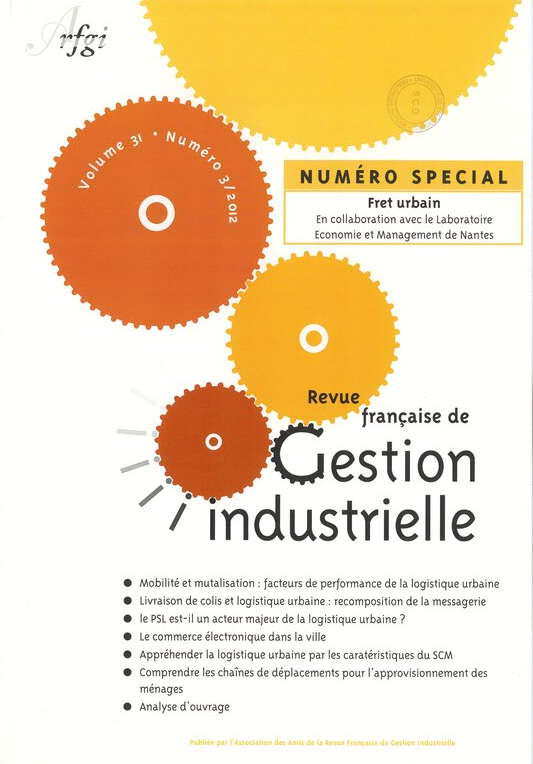Appréhender la logistique urbaine par les caractéristiques du supply chain management
DOI :
https://doi.org/10.53102/2012.31.03.664Mots-clés :
Logistique urbaine, Supply chain management, Quality function deploymentRésumé
Ce texte est un essai d'élargissement du concept de logistique urbaine dans une perspective systémique. Après avoir rappelé ce que sont le « supply chain management » et ses caractéristiques, la démarche « quality function deployment » est appliquée à la logistique urbaine. Les acteurs puis leurs attentes sont identifiés. Les caractéristiques-clés de la logistique urbaine en sont dérivées par l'utilisation de l'outil « maison de la qualité ».
Références
Bénavent C. & Meyer-Waarden L., (2005), « efficacité des programmes de fidélisation », congrès de l'AFM, Nancy
Brynjolfsson E., Renshaw A.A. & Van Alstyne M., (1996), The Matrix of Change: a Tool for Business Reengineering, The Sloan Management Review
Chen J., (2006), Management de la production, Ems, 2nde édition
Crepin D. & Rolin R., (2001), Résolution de problèmes Méthodes, outils de première et deuxième générations, Editions d'Organisation
Fijalkow Y., (2007), Sociologie des villes, Editions La Découverte, Paris
Fiske A.P., (1992), The Four Elementary Forms of Sociality: Framework for a Unified Theory of Social Relations. Psychological Review 99, 589-723
Handfield R. & Nichols Jr, E.,(1999), Introduction to Supply Chain Management, Prentice-Hall Hauser J. & Clausing D., (1988), The house of quality, Havard Business Review, Vol. N°3
Lejeune M. A., Yakova N., (2005), On Characterizing the 4 C's in Supply Chain Management, Journal of Operations Management, Vol. 23 Issue 1
Mentzer J., DeWitt J., Keebler J., Zacharia Z., (2001) Defining Supply Chain Management Journal of Business Logistics, Vo1.22, No. 2
Muther R., '1974), Systematic Layout Planning, 2nd Edition, Cahners Books, Boston
Orlicky J., (1975), Material Requirement Planning: The New Way of Life in Production and Inventory Management, McGraw-Hill
Pez V., (2008), Programmes de fidélité et réactance psychologique du consommateur, Dauphine, Cahier 381, novembre 2008.
Porter M., (1986), "L'avantage concurrentiel", InterÉditions Reichhed F., (1996), L'Effet Loyauté, Dunod
Samuelson, P.A. (1948), « Consumption Theory in Ternis of Revealed Preference », Economica, N.S., 15, p. 242-253.
Sheppard B., Sherman D., (1998),The grammars of trust: a model and general implication, Academy of Management Science Review, Vol 23, n° 3
Shiba S., Graham A. & Walden D., (1997),4 Révolutions du Management par la Qualité Totale, Dunod,
Noritake M., Yamada T. &, Isumitami T., (1999), Optimal size and location planning of public logistics terminals, Transportation Research Part E: Logistics and Transportation Review, Volume 35, Issue 3
Taniguchi E., (2001) City Logistics, Infrastructure Planning Review, Vol.18; n°1, page.1-16
Taniguchi E., Thompson R.G. and Yamada T., Visions for city logistics, in Logistics Systems for Sustainable Cities Proceedings of the 3rd International Conference on City Logistics (Madeira, Portugal, 25-27 June 2003)
Ward A. Liker J., Cristiano J. & Sobk II D., The second Toyota Paradox: how delaying Decision Can Make Better Cars Faster, Loan Management Review/Spring 1995
Wight O., Manufacturing Resource Planning: MRP II, Unlocking America's Productivity Potential, CBI Pub. Co, 1981
Zucker L., "Production of trust: Institutional sources of economic structure, 1840-1920". Organizational Behavior, Vol 8, 1986, 53-111
Numéro
Comment citer
Rubrique
Licence
(c) Tous droits réservés RFGI 2021

Ce travail est disponible sous licence Creative Commons Attribution - Pas d’Utilisation Commerciale 4.0 International.











